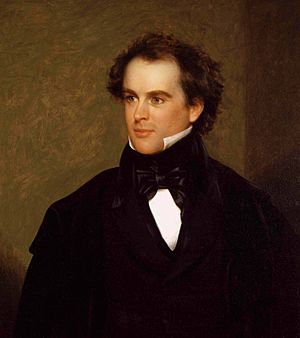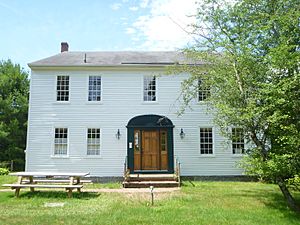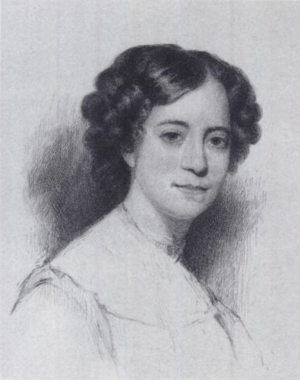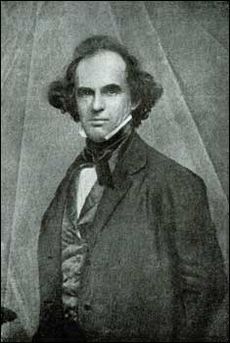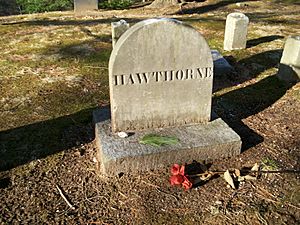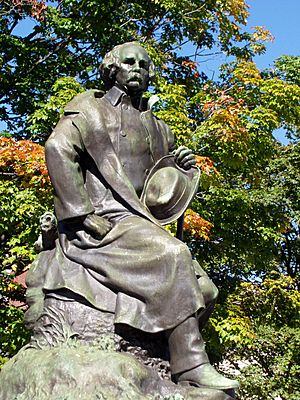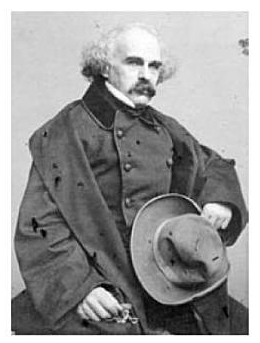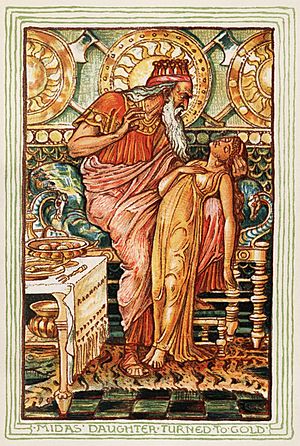Nathaniel Hawthorne facts for kids
Quick facts for kids
Nathaniel Hawthorne
|
|
|---|---|
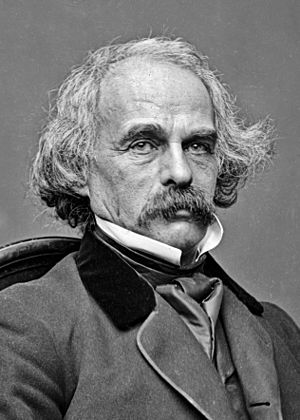
Hawthorne in the 1860s
|
|
| Born | Nathaniel Hathorne July 4, 1804 Salem, Massachusetts, U.S. |
| Died | May 19, 1864 (aged 59) Plymouth, New Hampshire, U.S. |
| Language | English |
| Alma mater | Bowdoin College |
| Notable works |
|
| Spouse |
Sophia Peabody
(m. 1842) |
| Children |
|
| Signature | |
Nathaniel Hawthorne (born July 4, 1804 – died May 19, 1864) was a famous American novelist and short story writer. He is best known for his dark and romantic stories, often set in early America. His most famous books include The Scarlet Letter and The House of the Seven Gables. He also wrote many short stories and a book about his friend, Franklin Pierce, who later became the 14th President of the United States.
Contents
Hawthorne's Early Life
Nathaniel Hawthorne was born on July 4, 1804, in Salem, Massachusetts. His father, Nathaniel Hathorne Sr., was a sea captain. Sadly, his father died in 1808 from a serious illness called yellow fever. Nathaniel was only four years old.
After his father's death, Nathaniel, his older sister Elizabeth, and younger sister Louisa moved to live with relatives in Salem. They stayed there for ten years. When he was nine, Nathaniel hurt his leg while playing. He was bedridden for a year, even though doctors couldn't find anything seriously wrong.
In 1816, his family moved to a new home built by his uncles in Raymond, Maine, near Sebago Lake. In 1819, he went back to Salem for school. He missed his mother and sisters very much.
With help from his uncle, Hawthorne went to Bowdoin College in 1821. He graduated in 1825.
Starting His Writing Career
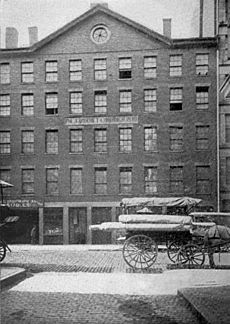
Hawthorne published his first book, Fanshawe: A Tale, in 1828. He didn't put his name on it. Even though it got good reviews, it didn't sell many copies.
In 1836, Hawthorne worked as an editor for a magazine called American Magazine of Useful and Entertaining Knowledge. In 1839, he got a job at the Boston Custom House. This job helped him earn money.
While working there, he wrote many short stories. Some of these were "Young Goodman Brown" and "The Minister's Black Veil". These stories didn't make him famous right away. However, his friend Horatio Bridge helped him publish a collection of these stories in 1837. This book was called Twice-Told Tales, and it helped him become known in his local area.
Marriage and Family Life
Nathaniel Hawthorne married Sophia Peabody on July 9, 1842. They lived in a house called The Old Manse in Concord, Massachusetts. While living there, Hawthorne wrote many of the stories that were later put into his book Mosses from an Old Manse.
The Hawthornes had three children. Their first child, Una, was born in 1844. Their son, Julian, was born in 1846. Their youngest daughter, Rose, was born in 1851. Hawthorne lovingly called Rose his "autumnal flower."
Later Years and Famous Works
In 1846, Hawthorne got a new job as a Surveyor for the Port of Salem. He earned $1,200 a year. But he lost this job in 1849 when a new president was elected.
After losing his job, Hawthorne went back to writing full-time. In March 1850, he published his most famous book, The Scarlet Letter. It was one of the first books to be mass-produced in America. It sold 2,500 copies in just ten days and earned Hawthorne a lot of money over the years.
In 1850, Hawthorne and his family moved to a small farmhouse in Lenox, Massachusetts. While there, he wrote two more important novels: The House of the Seven Gables (1851) and The Blithedale Romance (1852). He also published A Wonder-Book for Girls and Boys in 1851. This book was a collection of short stories that retold old myths for children.
Life at The Wayside
In May 1852, the Hawthornes moved back to Concord. They bought a house called The Hillside and renamed it The Wayside. Their neighbors in Concord included famous writers like Ralph Waldo Emerson and Henry David Thoreau. That same year, Hawthorne wrote a book about his friend, The Life of Franklin Pierce.
When Franklin Pierce became President in 1853, he gave Hawthorne a job as a United States consul in Liverpool, England. Hawthorne and his family lived in England for several years. His job ended in 1857 when Pierce's time as president was over.
The family returned to The Wayside in 1860. That year, Hawthorne's novel The Marble Faun was published.
Hawthorne's Death
Nathaniel Hawthorne died peacefully in his sleep on May 19, 1864. He was on a trip to the White Mountains in Plymouth, New Hampshire. He was buried in a part of Sleepy Hollow Cemetery, Concord, Massachusetts, known as "Authors' Ridge."
His wife, Sophia, and daughter, Una, were first buried in England. But in 2006, their remains were moved and reburied next to Hawthorne in Massachusetts.
Hawthorne's Writing Style
Hawthorne's stories are part of a style called romanticism, especially "dark romanticism". Many of his works are inspired by the history of Puritan New England. He often explored themes like sin, guilt, and morality.
He started his career mostly writing short stories. His four main novels were written between 1850 and 1860: The Scarlet Letter (1850), The House of the Seven Gables (1851), The Blithedale Romance (1852), and The Marble Faun (1860). He also wrote non-fiction books.
Interesting Facts About Nathaniel Hawthorne
- Nathaniel's last name was originally spelled "Hathorne." He added the "w" after college. He did this to distance himself from his ancestors.
- His great-great-great-grandfather, William Hathorne, was a judge known for harsh punishments. William's son, John Hathorne, was one of the judges during the famous Salem witch trials.
- Hawthorne had a very happy marriage with Sophia Peabody. He often called her his "Dove."
- At the start of the American Civil War, Hawthorne visited Washington, D.C. He met Abraham Lincoln and wrote about his experiences in an essay called "Chiefly About War Matters" in 1862.
Nathaniel Hawthorne Quotes
Here are some famous quotes from Nathaniel Hawthorne:
- "Words — so innocent and powerless as they are, as standing in a dictionary, how potent for good and evil they become in the hands of one who knows how to combine them."
- "Happiness in this world, when it comes, comes incidentally. Make it the object of pursuit, and it leads us a wild-goose chase, and is never attained."
- "It is a curious subject of observation and inquiry, whether hatred and love be not the same thing at bottom."
- "No man, for any considerable period, can wear one face to himself and another to the multitude, without finally getting bewildered as to which may be the true."
- "The young have less charity for aged follies than the old for those of youth."
Selected Works
Nathaniel Hawthorne wrote many books and stories. Here are some of his most well-known works:
Novels
- Fanshawe (published without his name, 1828)
- The Scarlet Letter, A Romance (1850)
- The House of the Seven Gables, A Romance (1851)
- The Blithedale Romance (1852)
- The Marble Faun: Or, The Romance of Monte Beni (1860)
Short Story Collections
- Twice-Told Tales (1837)
- Grandfather's Chair (1840)
- Mosses from an Old Manse (1846)
- A Wonder-Book for Girls and Boys (1851)
- The Snow-Image, and Other Twice-Told Tales (1852)
- Tanglewood Tales (1853)
Selected Short Stories
- "Young Goodman Brown" (1835)
- "The Minister's Black Veil" (1836)
- "Dr. Heidegger's Experiment" (1837)
- "The Birth-Mark" (1843)
- "Rappaccini's Daughter" (1844)
- "Ethan Brand" (1850)
- "The Great Stone Face" (1850)
Nonfiction
- Life of Franklin Pierce (1852)
- Our Old Home (1863)
See also
 In Spanish: Nathaniel Hawthorne para niños
In Spanish: Nathaniel Hawthorne para niños


